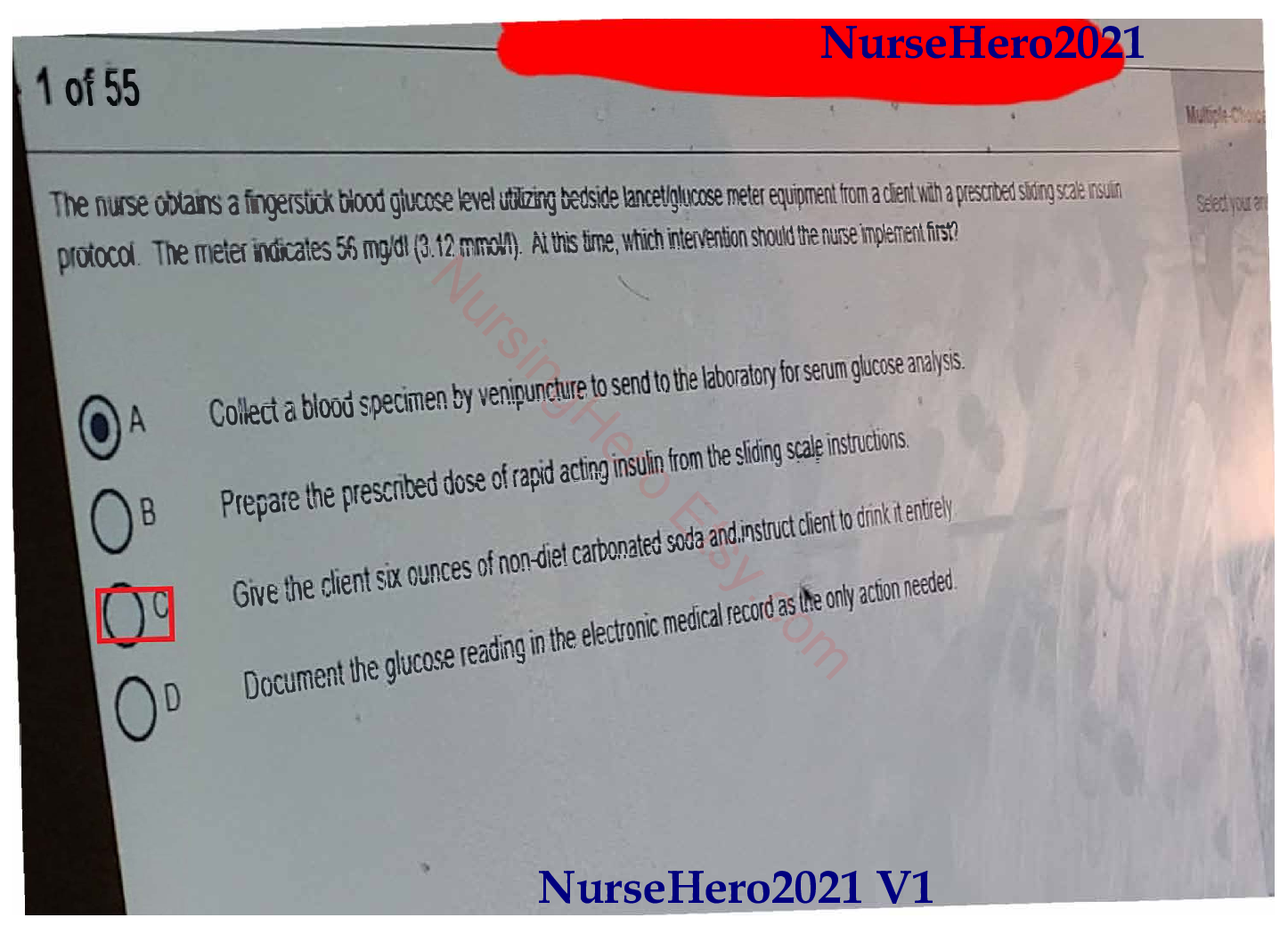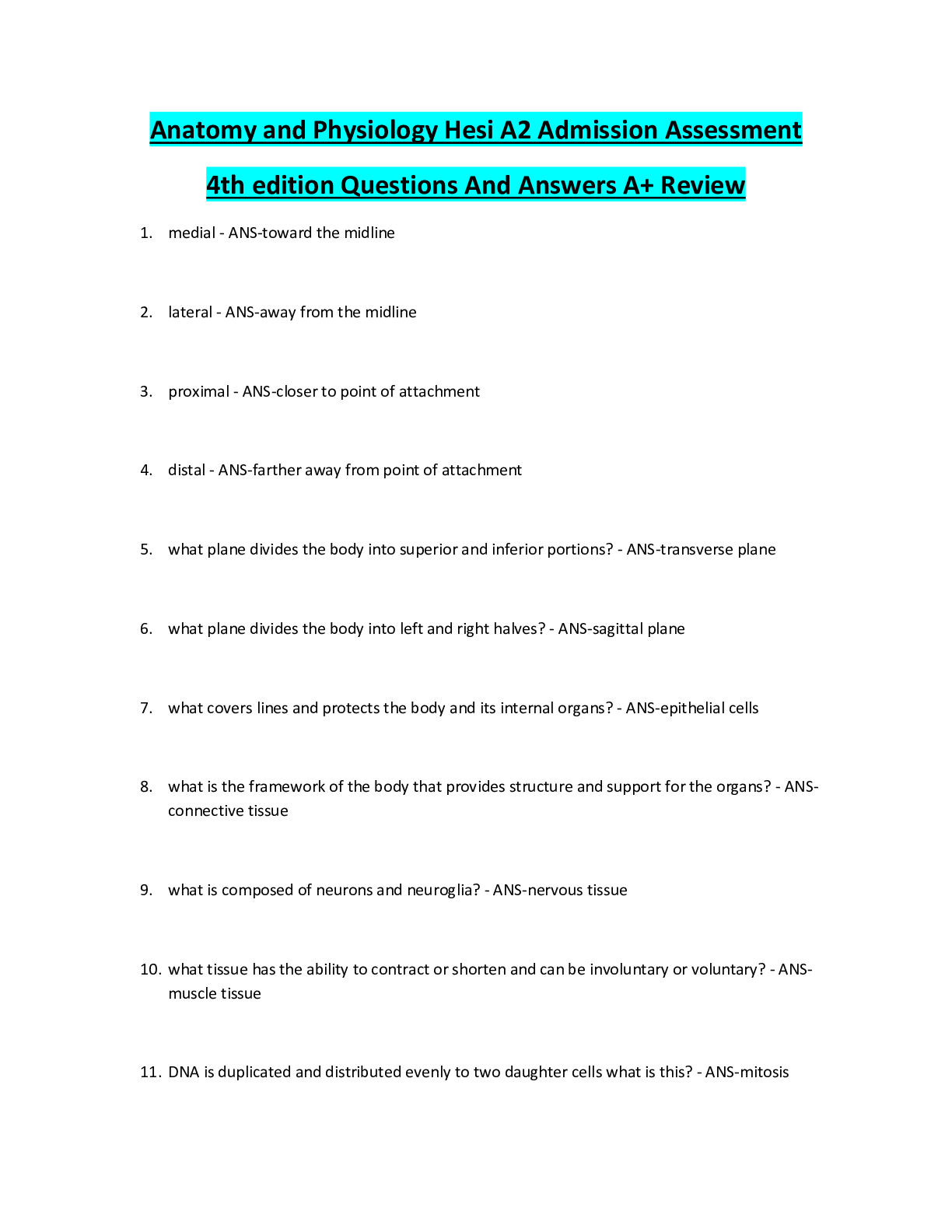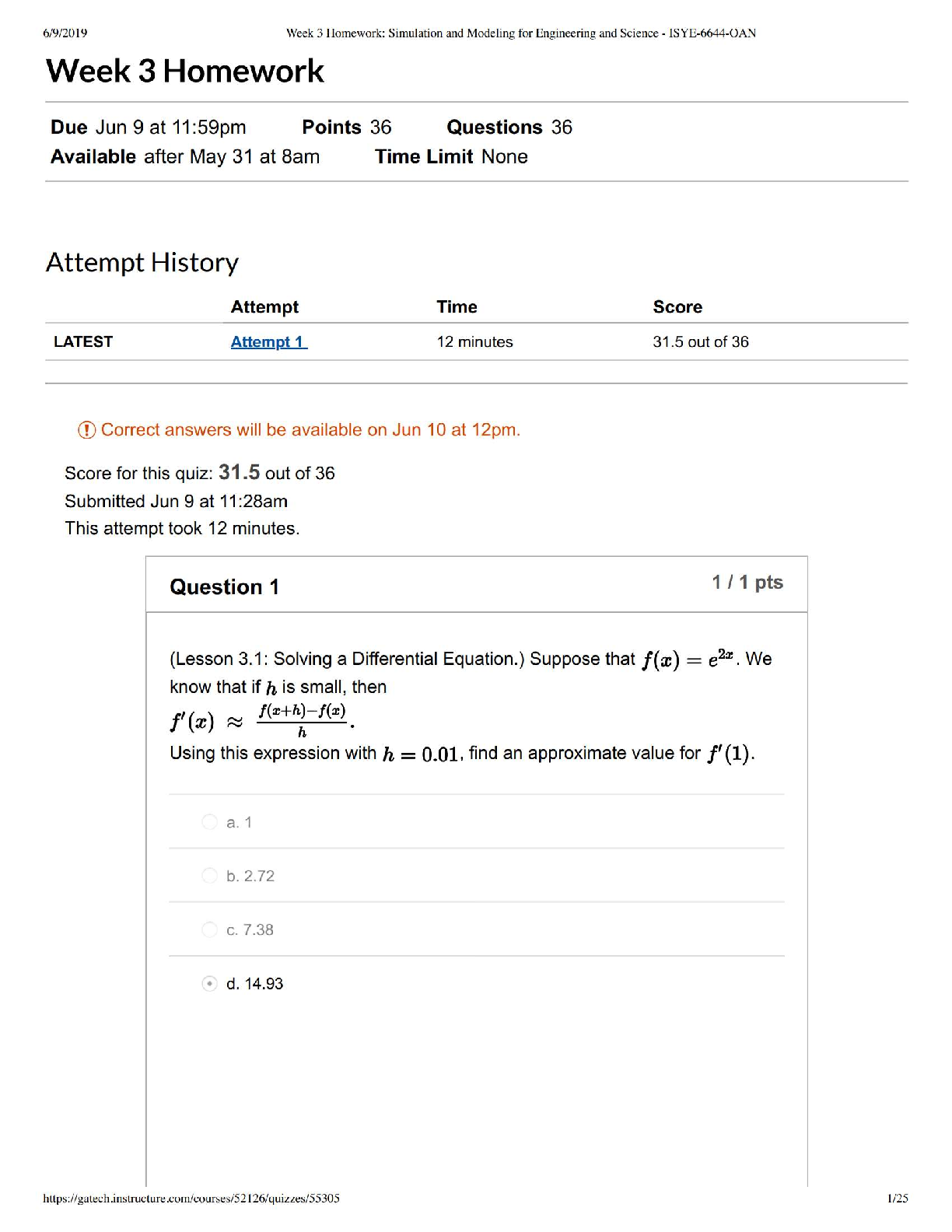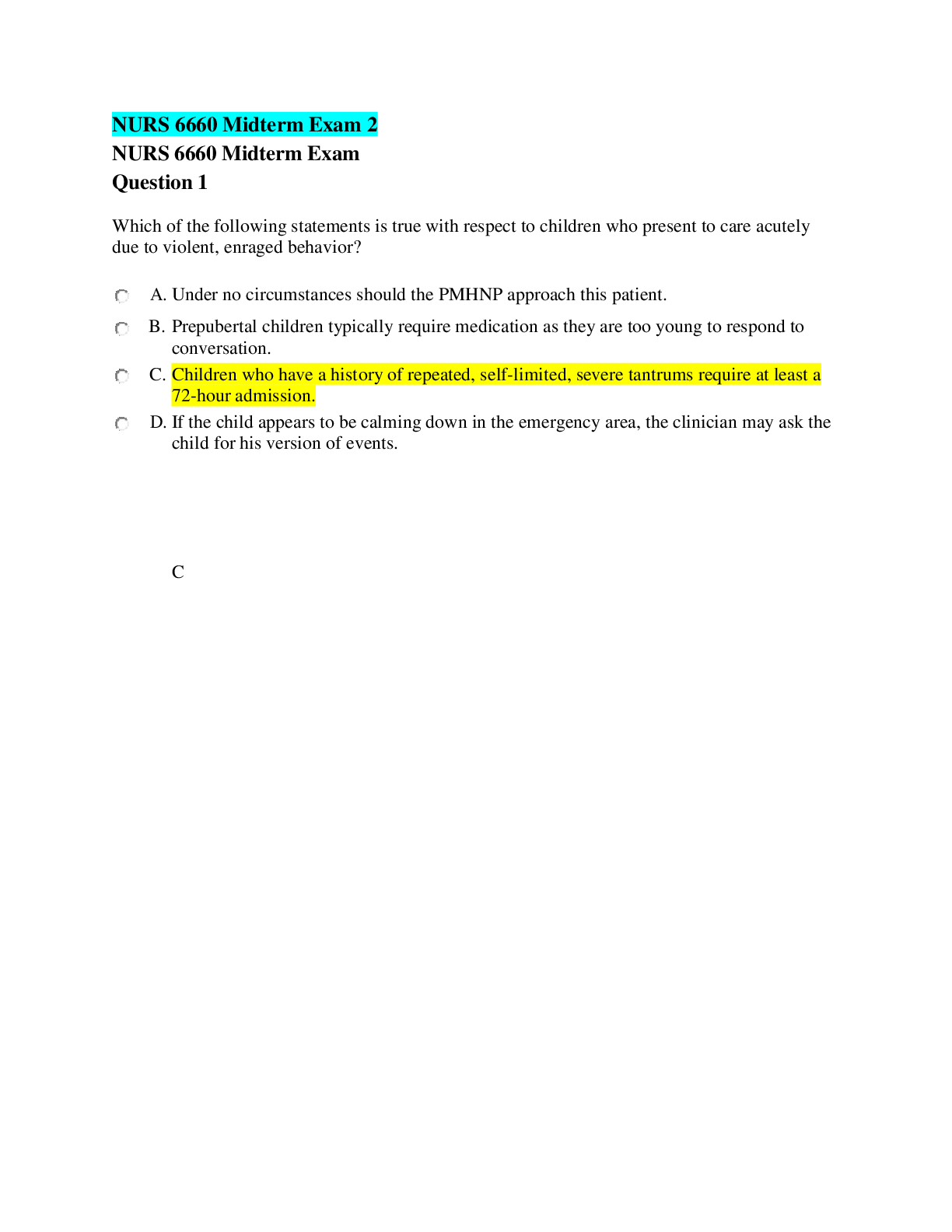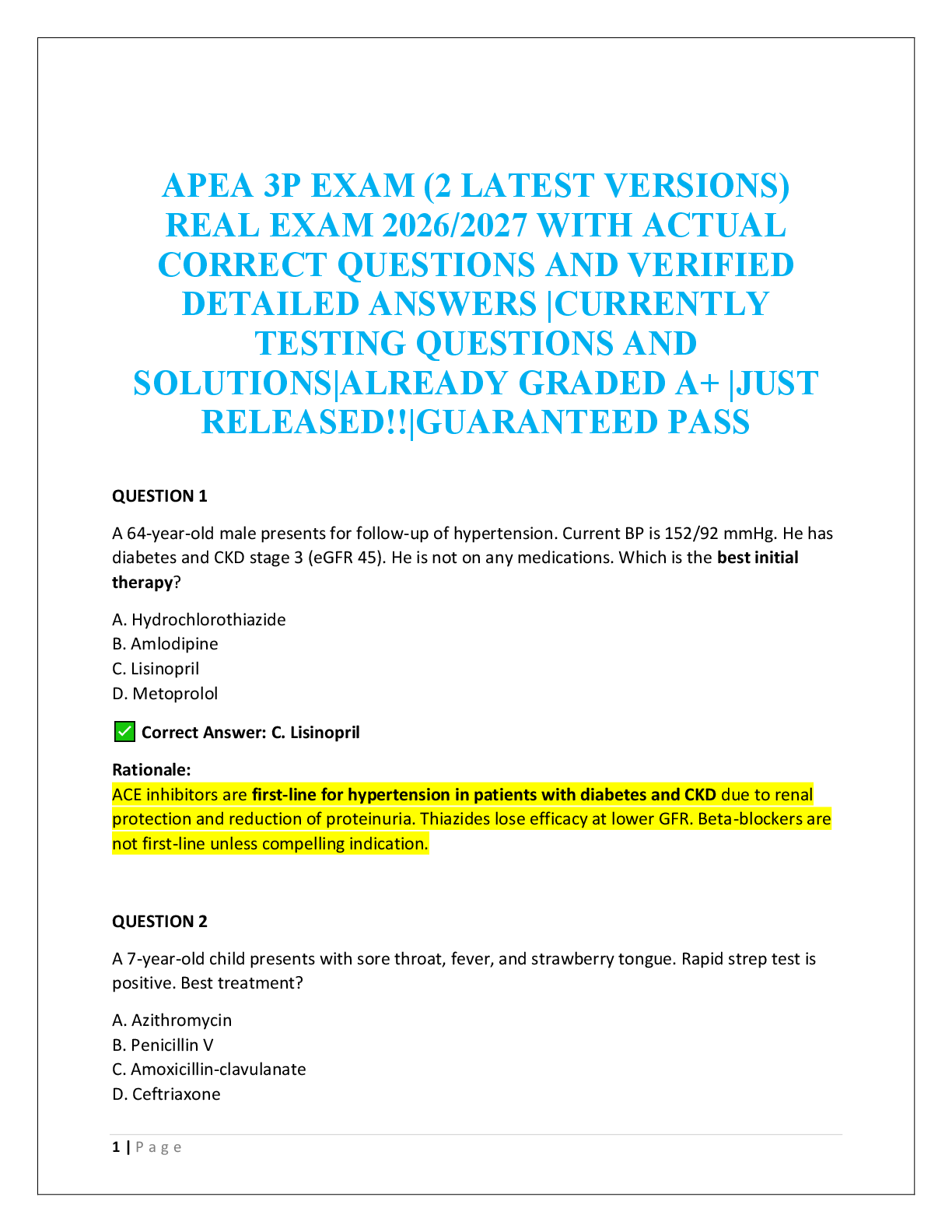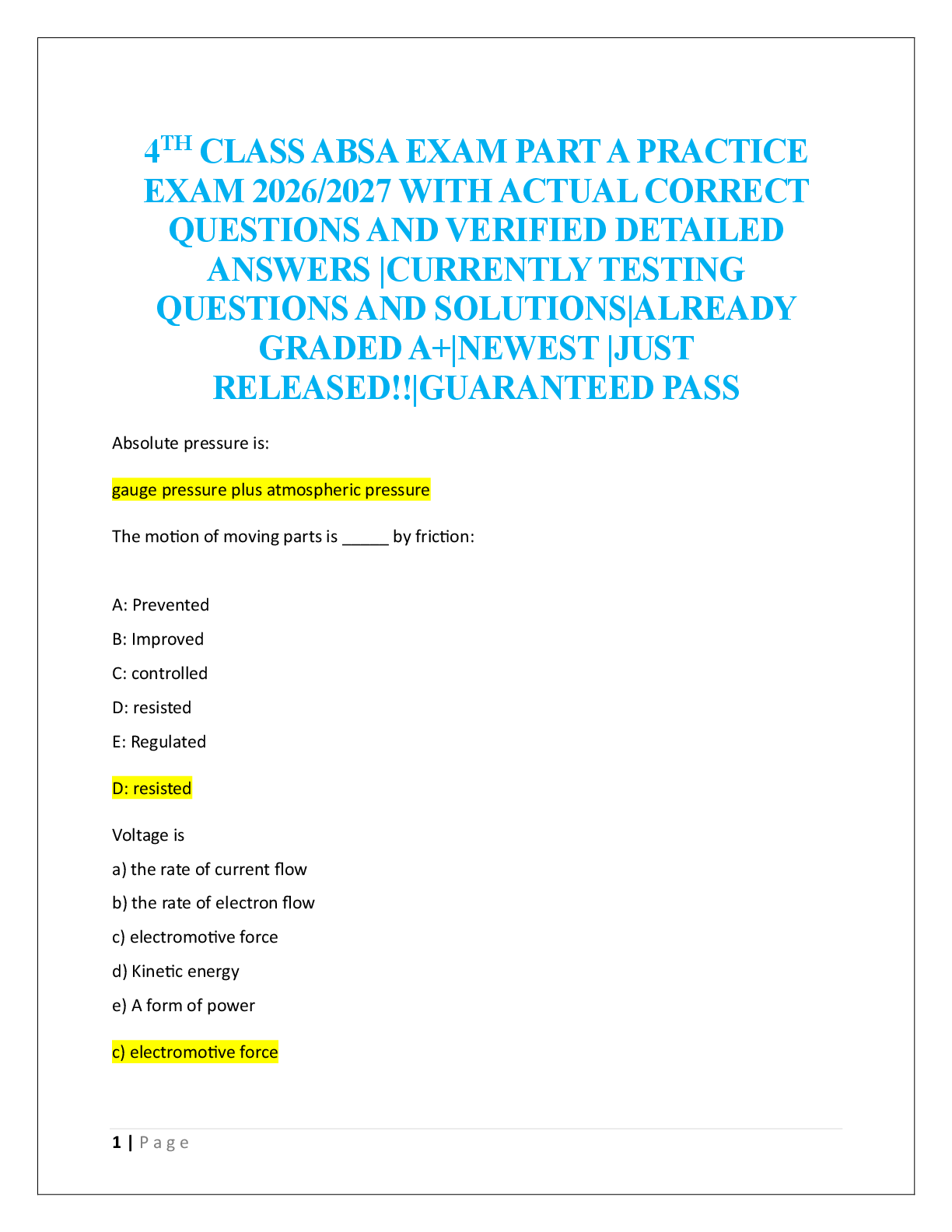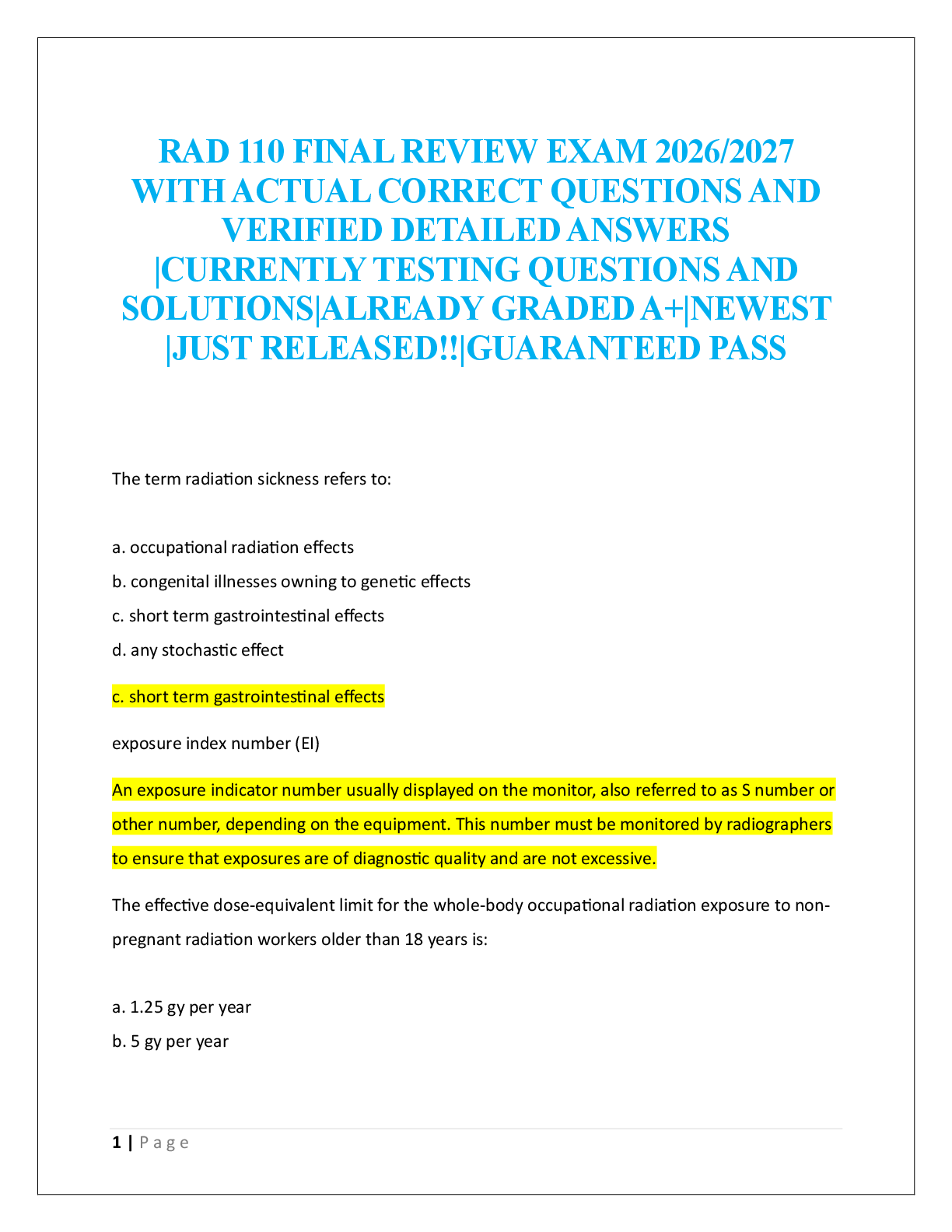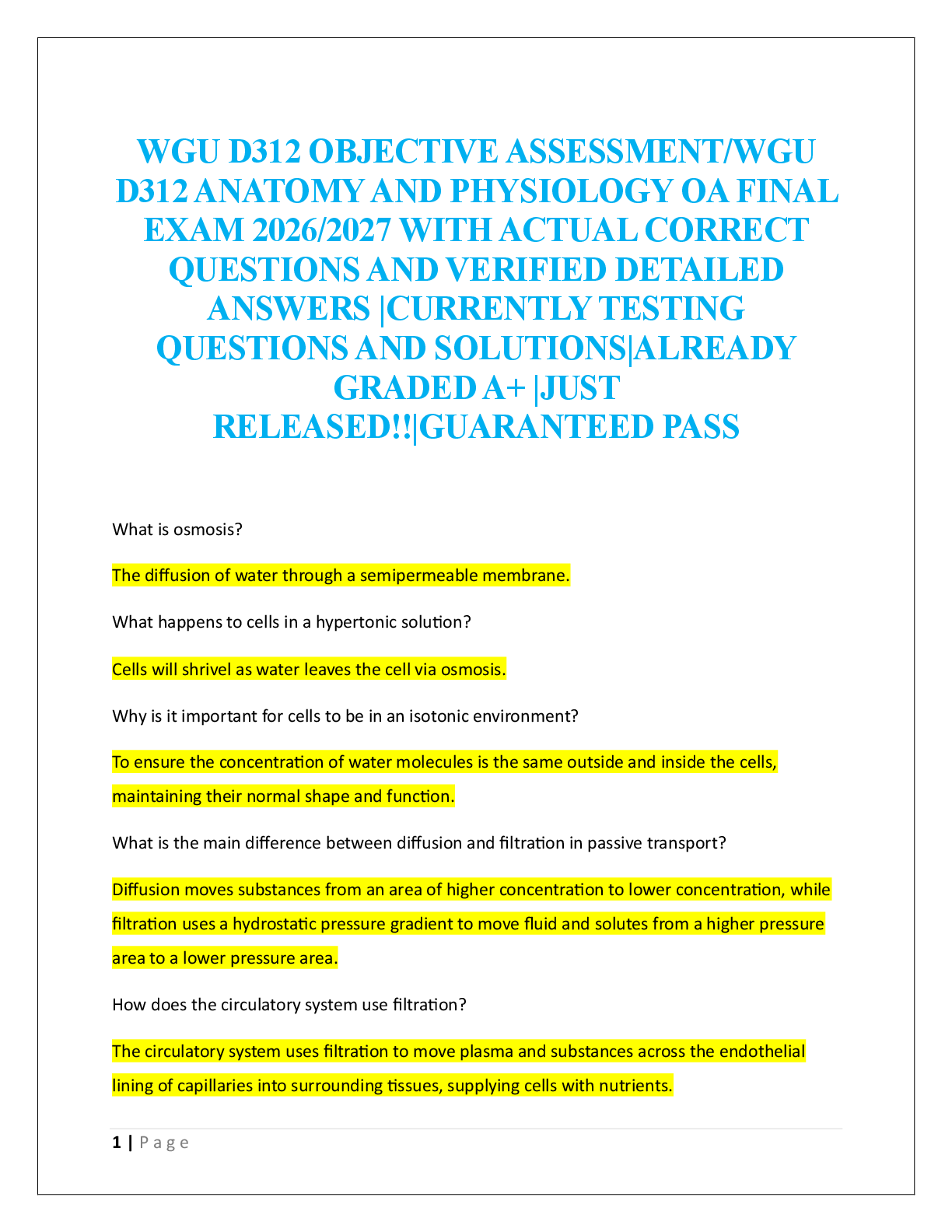LAS MAS MUS 337 Final Exam (spring 2020) complete Questions & Answers; attempt Score:97%.
Document Content and Description Below
LAS MAS MUS 337 FINAL EXAM SPRING 2020
Quiz: Scored 97%
Section II: Films--Multiple Choice (10 points)
Choose the correct answer in response to the question/prompt.
Question 1 (2 points)
...
According to the film, Alex Lora: Rock and Roll Made in Mexico, how was the view of the Mexican government towards Rock n' Roll during the '60s?
Question 1 options:
A) The Rock and Roll was banned in Mexico, and they were persecuted.
B) The government persecuted the groups that played “Refried” songs.
C) "Rhythm and blues” was the only genre that was permitted.
D) It became very popular and everyone liked it.
Question 2 (2 points)
According to the film, Compañeras, how did the women learn the mariachi tradition of music?
Question 2 options:
B) They learned in school.
C) They learned by imitating successful musicians.
Question 3 (2 points)
According to the film Compañeras, what main obstacle did the mariacheras have to overcome during their journey to become professional mariachis?
Question 3 options:
B) Machismo
C) It was difficult for them to learn the music
Question 4 (2 points)
According to the film, El Corrido Mexicano, the song, " Somos Más Americanos, by popular band Los Tigres del Norte, addresses what important issue, among others?
Question 4 options:
A) immigration
B) drug dealing
C) social diseases
D) religion
Question 5 (2 points)
According to the film, Sing and Don't Cry: The Mariachis, why is the Venezuelan mariachi
ensemble’s participation in the event significant to the larger genre of mariachi music? Question 5 options:
B) It shows the international appeal of the mariachi musical tradition.
C) It represents the similarities between mariachi and folk music from Venezuela.
Section V: Listening
Section I: Identifying Terms and Concepts Fundamental to Music and Dance—Matching (14 points)
Question 6 (6 points)
Match the element of music to its description. Question 6 options:
1.Dynamics
2. Form
5. Texture
3. Pitch
6. Timbre
4. Rhythm
Question 7 (4 points)
Match the element of dance to its description. Question 7 options:
1. Refers to the dancer him/herself
3.Use of floor patterns, direction, level, and shape
4.Amount of force expended in a given movement
2. Speed of movements and manipulation of rhythmic patterns
4. Effort
Question 8 (4 points)
Match the classification with the way in which its instruments produce sound. Question 8 options:
2. Membranophones
4.Idiophones 3.Chordophones
1. Aerophones
Section III: Text/Lecture--Multiple Choice (16 points)
Choose the correct answer in response to the question/prompt.
Question 9 (1 point)
Which of the following is an example of participatory performance? Question 9 options:
C) An open drum circle
D) A staged rock concert
Question 10 (1 point)
The reference to a despedida in the final chapter should call to mind this custom:
Question 10 options:
B) the sung farewell in a corrido.
C) a statement of protest in popular song.
Question 11 (1 point)
What is the Spanish term for “mixture” used in reference to racial blending and, later, syncretism of cultural features?
Question 11 options:
B) Essentialization
C) Stereotype
Question 12 (1 point)
José Pablo Moncayo's Huapango:
Question 12 options:
A) rejects the spirit of nationalism that shaped the opening decades of the 20th century.
B) is only played by symphonic orchestras and never played outside of Mexico.
C) was intended for performance by rural musicians.
D) has become a beloved symbol of Mexican identity.
Question 13 (1 point)
What is the six-beat pattern with varying accentuation, sometimes felt in two and other times in three, common in various Latin musics called?
Question 13 options:
A) Triple meter
B) Compound meter
C) Huapango
Question 14 (1 point)
Which of the following is another name for the dance music called, waila? Question 14 options:
B) Quebredita
C) Chicken scratch
Question 15 (1 point)
Why do practitioners of Danza Azteca take issue with Danza de los Concheros? Question 15 options:
C) The representation of women is misogynistic and further oppresses women in modern society.
D) Use of the concha represents European influence on indigenous practices.
Question 16 (1 point)
One of the earliest and most famous stars of rocanrol was: Question 16 options:
A) Gloría Rios
C) Judith Reyes
D) Julieta Venegas
Question 17 (1 point)
Which of the following was the singer-actor who became the idealized representative of the handsome, heroic rancher?
Question 17 options:
B) Jorge Negrete
C) Agustín Lara
Question 18 (1 point)
The guitar and other stringed instruments didn't exist prior to European contact and belong to this category.
Question 18 options:
A) Idiophone
B) Membranophone
C) Aerophone
D) Chordophone
Question 19 (1 point)
Which of the following is a guitar-like instrument with six double courses associated with
conjuntos norteños? Question 19 options:
B) Mandolin
C) Guitarrón
Question 20 (1 point)
Villancicos were one of the most important genres of music to develop in vice-regal Mexico and offered a vehicle for:
Question 20 options:
A) inserting popular music styles into the formal liturgy.
B) giving space to women composers.
C) sharing new instruments imported from Germany, like the accordion.
D) teaching the congregation high Latin.
Question 21 (1 point)
Which of the following is a Spanish genre of musical theater characterized by a mixture of sung and spoken dialogue?
Question 21 options:
A) Kunqu
B) Zarzuela
C) Opera
D) Noh
Question 22 (1 point)
What is the foot-stomping heard in Mexican son that creates rhythmic accents called? Question 22 options:
B) Ceili
C) Baile
Question 23 (1 point)
Independence Day in Mexico is:
Question 23 options:
A) May 5th.
B) April 15th.
C) September 16th.
D) December 25th.
Question 24 (1 point)
The mega-genre of Mexican dance song, called son, is defined by which three dimensions? Question 24 options:
B) Verse, instrumentation, and choreography
C) Music, verse, and choreography
Section IV: Text/Lecture--True-False (15 points)
Select T (true) or F (false) for the following statements.
Question 25 (1 point)
All societies have music, but music is not a universal language. Question 25 options:
Question 26 (1 point)
Another term for “traditional” music is “folk” music.
Question 26 options:
True
False
Question 27 (1 point)
The beginning of the nationalist movement in Mexican classical music began with the establishment of the Orquesta Sinfónica Nacional in 1928 and ended with the death of composer Silvestre Revueltas in 1940.
Question 27 options:
True
False
Question 28 (1 point)
Classical music is distinct in that it requires very specialized training to understand and perform and is typically based upon a theoretical system, like notation.
Question 28 options:
True
False
Question 29 (1 point)
Banda is a broad style of Mexican dance music popularized by the wind bands of Sinaloa. Question 29 options:
Question 30 (1 point)
Popular music refers to music mostly from the 1980s-1990s, especially music that includes electric guitar, bass, and keyboards.
Question 30 options:
True
False
Question 31 (1 point)
Canto nuevo (a.k.a. nueva canción and nueva trova) was a song movement easily identified by the women who invariably fronted the bands to represent the gender equality for which it was striving.
Question 31 options:
True
False
Question 32 (1 point)
A song structured in verse form with different text, but the same melody is known as strophic.
Question 32 options:
True
False
Question 33 (1 point)
Flor silvestre (1943) is a film that provides a social critique of the Mexican Revolution in its music and narrative.
Question 33 options:
True
False
Question 34 (1 point)
The huéhuetl (single-headed drum with carved wooden base) is categorized as an idiophone. Question 34 options:
Question 35 (1 point)
Francisco "Pancho" Villa (1878-1923) was a major leader during the Mexican Revolution. Question 35 options:
Question 36 (1 point)
The romance is a poetically conceived ballad song and ancestor to the modern corrido.
Question 36 options:
True
False
Question 37 (1 point)
The Porfiriato was a period of social degradation and oppression of freedom, but with a lot of economic and infrastructure improvements in Mexico.
Question 37 options:
True
False
Question 38 (1 point)
Son istmeño is well known for its characteristic instrument, the pinkillu. Question 38 options:
Question 39 (1 point)
Porfirio Diaz is most well known for his rallying cry for Mexican independence, "death to the
gachupines." Question 39 options:
39 of 39 questions saved
Internet connection lost. No longer saving answers...Internet connection restored! Saving all answers...
[Show More]
Last updated: 3 years ago
Preview 1 out of 13 pages

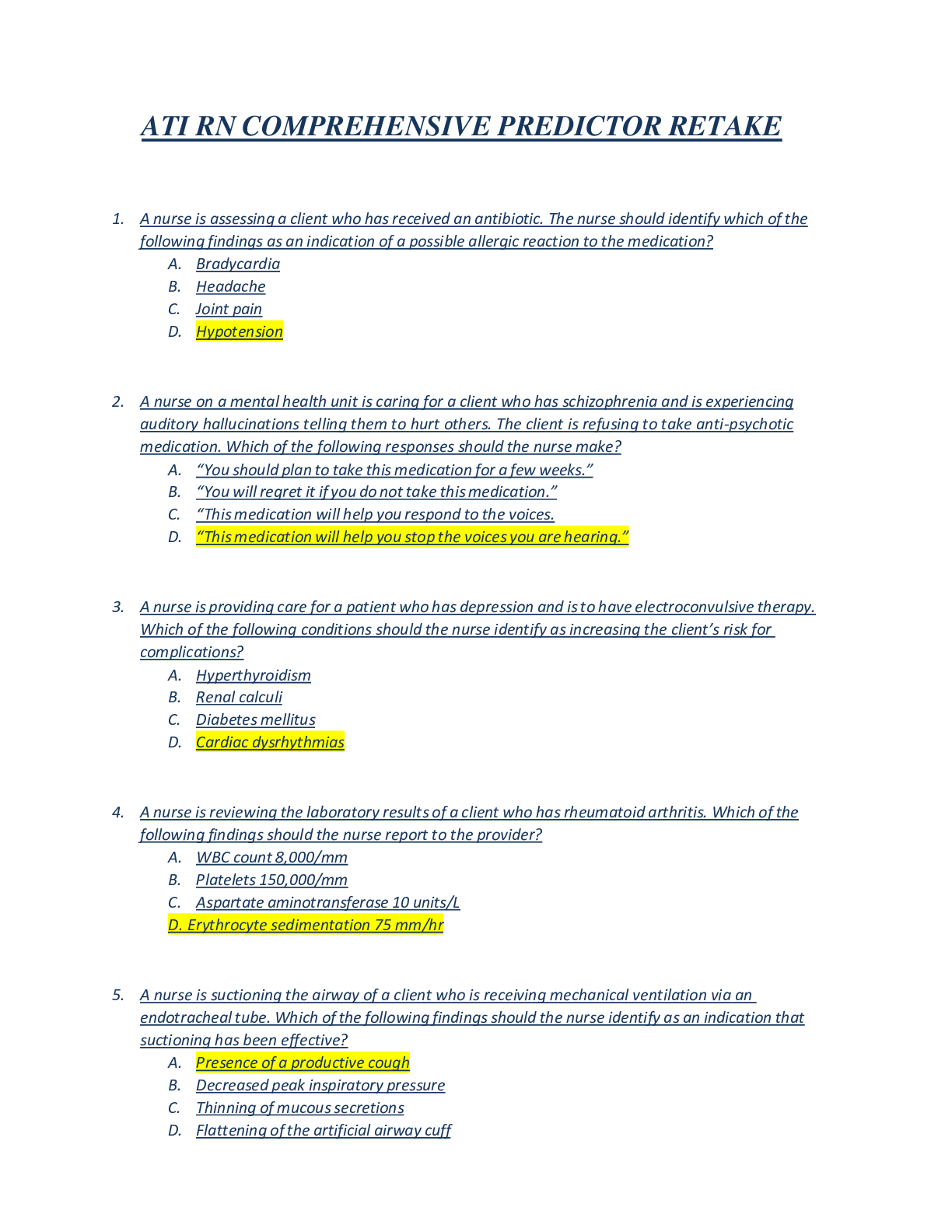
.png)

.png)
